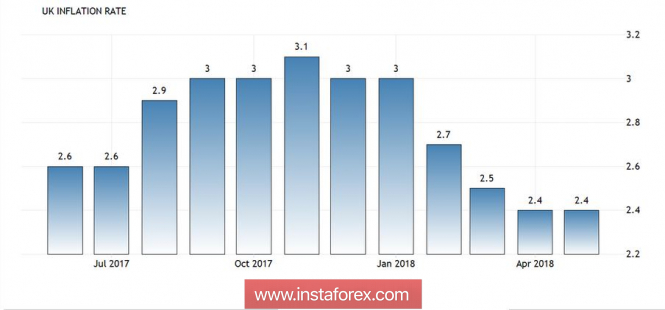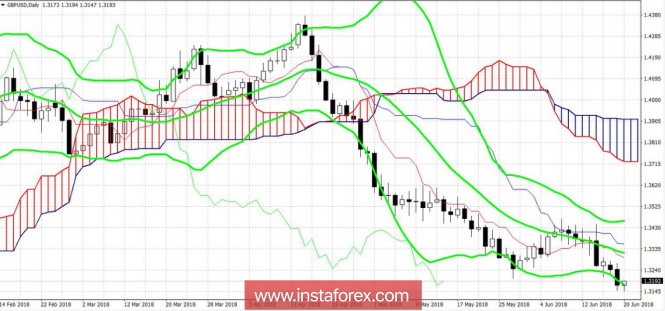
The British currency paired with the dollar continues to surrender its position, yielding to the pressure of a negative fundamental background. The pound still holds within 30 figures, but tomorrow's events can break the resistance of bulls and take the price to the area of 1.29. It all depends on the rhetoric of the Bank of England, which will hold its regular meeting on Thursday. If the regulator destroys hopes for the August rate hike, the southern trend will receive an additional impetus for its development.
At the moment, experts estimate the likelihood of an increase in the interest rate this summer. The average chance is 50/50. Each of the scenarios has its arguments "for" and "against." The fundamental background for the pound is too contradictory for unambiguous conclusions or forecasts.
Conditionally, all the fundamental factors affecting the pound's exchange rate can be divided into two parts. First, the dynamics of key economic indicators, and secondly, it is Brexit. If we talk about macrostatistics, then there is no distinct uniformity. On the one hand, the consumer price index in annual terms remains above two percent, despite a slowdown at the beginning of this year. On a monthly basis, this indicator also remained at the level of the previous month, that is, at the level of 0.4%. The unemployment rate continues to show positive dynamics, the indicator is kept at a record low level of 4.2%. The average salary increases, albeit at a very uncertain pace.

On the other hand, the British economy in the first quarter of this year grew by only one-tenth of a percent (in relation to the fourth quarter of last year) and only by 1.2% on an annualized basis. This is also a record, only with a minus sign. Such a weak growth rate was recorded for the last time six years ago. It should also be recalled that the English regulator at the May meeting lowered the country's GDP growth forecast in 2018 to 1.4%. Although in the winter, the expectations of the Central Bank were more ambitious - 1.8%. In the piggy bank of negative factors, we can also refer to the main PMI indices, which after a significant decline at the beginning of the year demonstrate a weak recovery.
But here, it should be recalled that in the winter-spring period this year in Great Britain, the rampant elements raged, which took the scale of the national catastrophe. In some regions of the country, the orange threat level was declared. That is, tathird of four possible. Such anomalous weather affected many (almost all) sectors of the British economy. Primarily tourism, services, manufacturing and the construction sector suffered. Losses were counted in colossal amounts, and the main indicators significantly "sagged," including PMI indices. Such circumstances will affect the dynamics of GDP growth in the second quarter of this year, and in general for the annual growth of the economy.
However, most members of the English regulator (including Mark Carney) are confident that the slowdown in key indicators at the beginning of the year is due to weather conditions, and in the second half of the year, the economy will recover. Indirectly, this is confirmed by the latest PMI data and inflation. However, according to some analysts, the regulator will not announce a rate increase tomorrow. The Bank of England will take an "extra minute" until the fall to make sure that the main indicators really increase the pace.
But the main factor of uncertainty is not related to economic growth, but to Brexit. On the eve of the EU summit, British politicians clashed in a tough confrontation about the prospects of a "divorce" process. Let me remind you that the deputies of the Lower House of the British Parliament last week voted against the key amendment to the law on Brexit, according to which the Cabinet of Ministers was obliged to preserve the country within the customs union with the EU. It is this factor that has become the next impulse to reduce GBP / USD to the 31st figure.
But just at these moments in the Lower House of Parliament again there is a debate. Already about the draft law, which gives the right to deputies to block through veto an agreement signed by the government. Earlier, the House of Lords (the upper house of the British Parliament) supported this bill. Thus, if the project is approved by the House of Commons, parliamentarians will be able to stop Brexit by their decision. To some extent, this will "tie hands" to Theresa May in the course of the second negotiating stage with Brussels.
Thus, at the moment, there are too many elements of risk for tightening the terms of monetary policy. And although at the meeting tomorrow, the Bank of England is not going to raise the interest rate, it is unlikely that it will tighten its rhetoric. Mark Carney certainly prefers to wait for the results of the EU summit, while making sure of the dynamics of inflationary growth.

This disposition suggests that the British Central Bank will not signal a rate hike in August, without excluding, however, such a scenario. Lack of clear intent and determination will negatively affect the pound, and paired with the dollar, it can test the next support level of 1.3105 (the bottom line of the Bollinger Bands indicator on the weekly chart). If the regulator still leaves the "place for maneuver" and reassures the markets, the corrective growth of GBP / USD can be used as an excuse for opening short positions. Uncertainty with Brexit and all sorts of rumors around the upcoming summit will exert pressure on the pound in the near future.